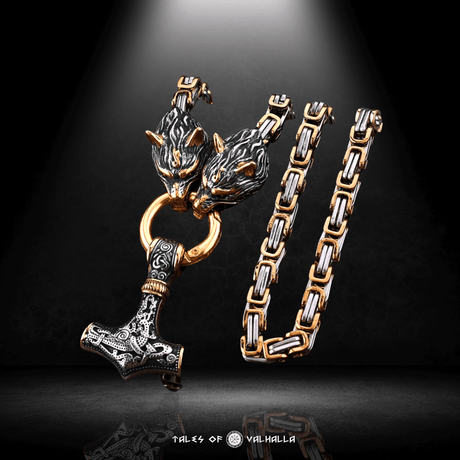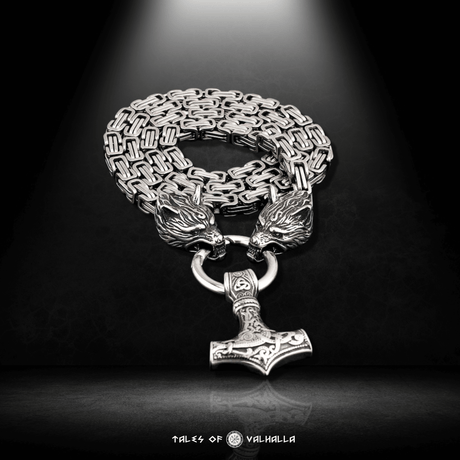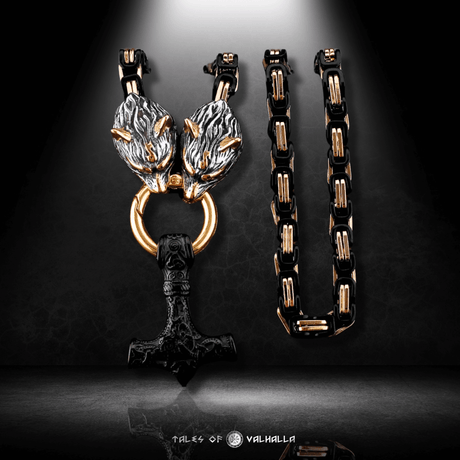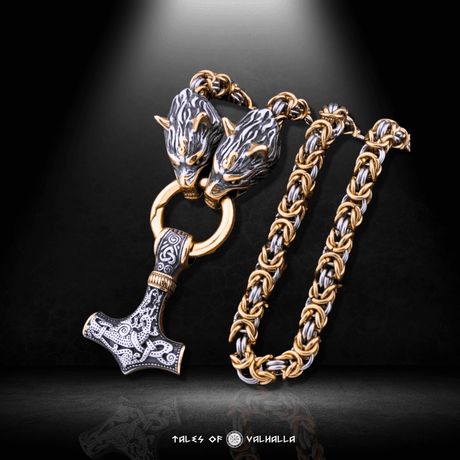Norse mythology offers a vast and intricate pantheon of gods and goddesses, each representing aspects of nature, life, and the mysterious forces shaping the world. This ancient belief system, passed down through Viking sagas and Scandinavian folklore, weaves tales of power, wisdom, and valor among the gods who reside in the Nine Realms. Whether you're new to Norse mythology or an enthusiast, this guide to 11 Norse gods and goddesses illuminates their roles, personalities, and significance within Viking lore.
The Pantheon of Norse Gods
The Viking mythology gods were organized in two primary tribes: the Aesir and the Vanir. The Aesir, including prominent figures like Odin and Thor, were primarily associated with war, governance, and the natural order. The Vanir, with gods like Freyja and Njord, were connected to fertility, nature, and prosperity. These tribes once clashed in a mythical battle, later uniting to form a more powerful collective.
This pantheon is rich with stories of adventure, wisdom, and transformation. Below are 11 of the most influential Norse gods and goddesses, each holding a unique place within Norse mythology.
1. Odin – The Allfather
Role: King of the Aesir, god of wisdom, war, and death
Odin, often called the Allfather, is the chief of the Norse gods and a central figure in Norse mythology. Known for his relentless pursuit of knowledge, Odin sacrificed his eye to drink from the Well of Mimir, gaining unmatched wisdom. He also hung himself on Yggdrasil, the World Tree, for nine days and nights to uncover the secrets of the runes.
Odin’s thirst for knowledge and strength to face sacrifice symbolize the Norse values of wisdom, bravery, and resilience. His two ravens, Huginn and Muninn, fly across the realms, bringing him information, and his eight-legged horse, Sleipnir, can travel through different worlds. Odin’s complex character embodies both benevolence and a ruthless, calculating nature, making him one of the most dynamic gods in Norse mythology.
2. Frigg – Goddess of Marriage and Motherhood
Role: Queen of the Aesir, goddess of marriage, motherhood, and prophecy
As Odin’s wife and queen of the Aesir, Frigg holds a high position among the Norse pantheon. She is a goddess of marriage, motherhood, and household, often associated with foresight and wisdom. Frigg’s power of prophecy allows her to foresee the fate of those she loves, though she rarely interferes.
Her loving, protective nature is particularly evident in her relationship with her son, Balder. When Balder had prophetic dreams foretelling his death, Frigg secured promises from all things to protect him—except mistletoe. Frigg’s role in Norse mythology highlights the importance of family, loyalty, and foresight in Viking culture.
3. Thor – God of Thunder and Protector of Midgard
Role: God of thunder, strength, and protection
Thor, the mighty god of thunder, is perhaps one of the most recognized Norse mythology gods. Known for his red beard, immense strength, and famous hammer, Mjölnir, Thor was the protector of gods and humans alike. He was a fierce warrior who fought giants, trolls, and other threats to Asgard and Midgard.
Thor’s popularity among Norse people was vast, as his dedication to protecting the world resonated deeply with Viking warriors. As a god of strength, courage, and loyalty, he embodied the Norse warrior spirit. His hammer, Mjölnir, symbolizes protection and consecration, a revered symbol in Viking artifacts and jewelry.
4. Loki – The Trickster God
Role: God of mischief, trickery, and chaos
Loki stands out as a complex figure within the pantheon of Norse gods. Known as a shape-shifter and trickster, Loki’s actions frequently disrupted the lives of gods and humans. His role is ambiguous; while he often causes trouble, he also plays a significant part in helping the gods on occasion.
Loki’s character highlights the Norse appreciation for cunning and intelligence, albeit with a cautious acknowledgment of its potential dangers. His unpredictable nature ultimately leads to his imprisonment by the gods, but he remains a fascinating, morally ambiguous figure in Viking mythology.
5. Freyja – Goddess of Love, Fertility, and War
Role: Goddess of love, beauty, fertility, and war
Freyja, one of the most prominent Norse goddess names, is revered for her dual role in love and war. She is associated with beauty, love, and fertility but also possesses a fierce warrior aspect. Freyja rides a chariot drawn by cats and is known for her magical necklace, Brísingamen, symbolizing her enchanting beauty and power.
As a leader of the Valkyries, Freyja had a significant role in guiding fallen warriors to Folkvangr, her own realm of the afterlife. Freyja’s character embodies both tenderness and ferocity, demonstrating the Norse appreciation for balance and strength.
6. Tyr – God of War and Justice
Role: God of war, law, and justice
Tyr is a god of war known for his courage and sense of justice. His most famous tale involves the wolf Fenrir, whom the gods tried to bind as he posed a threat to the Nine Realms. Tyr placed his hand in Fenrir’s mouth as a gesture of trust, which Fenrir bit off when he realized the gods intended to bind him.
Tyr’s bravery and commitment to justice embody the Viking values of honor and sacrifice. As a god who upheld law and justice, Tyr was deeply respected among Norse people, symbolizing the moral foundation of their society.
7. Balder – God of Light and Purity
Role: God of beauty, love, light, and purity
Balder, son of Odin and Frigg, is a beloved god associated with light, purity, and beauty. Known for his kindness and wisdom, Balder is considered one of the most noble Norse gods. His tragic death, orchestrated through Loki’s trickery, marks a significant event in Norse mythology.
Balder’s death, caused by a mistletoe dart, represents the vulnerability of goodness and foreshadows Ragnarok. His story emphasizes themes of innocence, betrayal, and the inevitability of fate, deeply resonant in Norse culture.
8. Heimdall – Guardian of Bifrost
Role: Guardian of Bifrost, the rainbow bridge between Midgard and Asgard
Heimdall is the vigilant watchman of the gods, stationed at the Bifrost bridge to guard against invaders. He possesses heightened senses, capable of hearing the grass grow and seeing for hundreds of miles. Known for his loyalty and dedication, Heimdall is a symbol of vigilance and duty.
Heimdall’s presence as a protector highlights the importance of vigilance and loyalty in Norse society. His eternal watch underscores the value of safeguarding one’s realm and loved ones.
9. Njord – God of the Sea, Wind, and Wealth
Role: God of the sea, wind, and prosperity
Njord, one of the Vanir gods, governs the sea, wind, and prosperity. He is the father of Freyja and Freyr and is highly revered for his ability to bring wealth through successful sea voyages and trade. Njord’s blessings were essential for the seafaring Vikings, who relied on his goodwill for safe travel and abundant resources.
As a god of both the ocean and wealth, Njord’s dual role reflects the Norse respect for nature and prosperity, as well as the reliance on the sea for survival and trade.
10. Freyr – God of Fertility and Harvest
Role: God of fertility, agriculture, and prosperity
Freyr, brother of Freyja, is a Vanir god associated with fertility, peace, and bountiful harvests. His connection to agriculture made him a crucial deity for the Norse people, who depended on good harvests. Freyr’s powerful sword, which could fight on its own, made him both a symbol of abundance and protection.
Freyr’s role represents the importance of nature and harmony in Viking life. His blessings ensured prosperity, making him one of the most beloved Norse mythology gods.
11. Hel – Goddess of the Underworld
Role: Ruler of Helheim, goddess of the dead
Hel, daughter of Loki, is the ruler of Helheim, the realm where those who did not die in battle reside after death. Hel embodies a calm acceptance of death, ruling her domain with a sense of inevitability and separation from the realms of the living. While her appearance is said to be half alive and half dead, she is not portrayed as malicious.
Hel’s realm symbolizes the Norse understanding of death as a natural, neutral state, with Hel overseeing this process. Her story reminds us of the Norse focus on life, death, and the cyclical nature of existence.
Embracing the Norse Pantheon
The Norse mythology gods continue to inspire and fascinate people worldwide. Their stories of heroism, wisdom, and mystery resonate with universal themes, providing insight into a culture that valued bravery, family, and the wisdom of the natural world. Modern interest in Viking mythology gods is evident in everything from movies and books to the growing popularity of Norse-inspired jewelry and apparel.






























































































